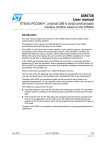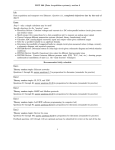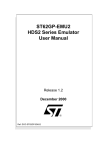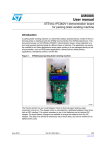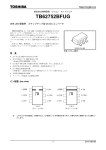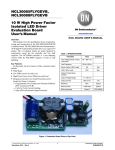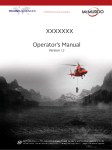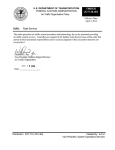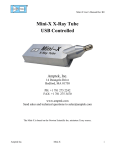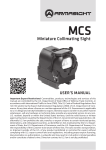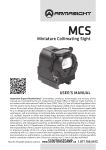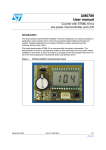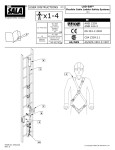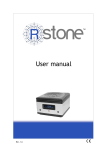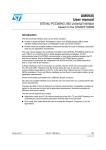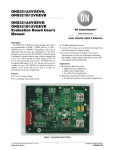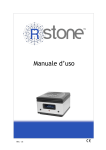Download STEVAL-IHM012V1 - Cordless drill evaluation board - Digi-Key
Transcript
UM0291 User manual STEVAL-IHM012V1 - Cordless drill evaluation board Introduction This document contains cordless drill evaluation board information, including jumper settings, load connection, and device and software features. This evaluation board implements a traditional design solution detailing how the Chopper circuit controls a brush DC motor with a microcontroller as a driver. The electronic driver with a Power MOSFET and microcontroller presented in this document is cost-effective and easy for designers to implement. This solution can be typically used in cordless tools, shavers, toys and machine tools. Analog solutions are being progressively replaced by microcontroller designs even in low-cost applications. Their advantages include flexibility, using less external components, easy adaptation by simple software modifications, and control components can be designed with a potentiometer. October 2007 Rev 3 1/18 www.st.com Contents UM0291 Contents 1 Block diagram of a single switch Chopper . . . . . . . . . . . . . . . . . . . . . . . 4 1.1 Controller . . . . . . . . . . . . . . . . . . . . . . . . . . . . . . . . . . . . . . . . . . . . . . . . . . 4 1.2 Power MOSFET . . . . . . . . . . . . . . . . . . . . . . . . . . . . . . . . . . . . . . . . . . . . . 5 1.3 Power supply . . . . . . . . . . . . . . . . . . . . . . . . . . . . . . . . . . . . . . . . . . . . . . . 5 1.4 Freewheeling diode . . . . . . . . . . . . . . . . . . . . . . . . . . . . . . . . . . . . . . . . . . 5 2 STEVAL-IHM012V1 evaluation board . . . . . . . . . . . . . . . . . . . . . . . . . . . . 6 3 Size optimization design procedure . . . . . . . . . . . . . . . . . . . . . . . . . . . . 7 4 Application design procedure . . . . . . . . . . . . . . . . . . . . . . . . . . . . . . . . . 8 5 4.1 Zener regulator circuit . . . . . . . . . . . . . . . . . . . . . . . . . . . . . . . . . . . . . . . . 8 4.2 Sensing resistor (RSENS) . . . . . . . . . . . . . . . . . . . . . . . . . . . . . . . . . . . . . . 9 4.3 Power MOSFET . . . . . . . . . . . . . . . . . . . . . . . . . . . . . . . . . . . . . . . . . . . . . 9 Software . . . . . . . . . . . . . . . . . . . . . . . . . . . . . . . . . . . . . . . . . . . . . . . . . . 11 5.1 Main.c . . . . . . . . . . . . . . . . . . . . . . . . . . . . . . . . . . . . . . . . . . . . . . . . . . . . 12 5.2 pwm_ar_timer_12bit.c . . . . . . . . . . . . . . . . . . . . . . . . . . . . . . . . . . . . . . . 13 6 Field tests . . . . . . . . . . . . . . . . . . . . . . . . . . . . . . . . . . . . . . . . . . . . . . . . . 14 7 Schematic . . . . . . . . . . . . . . . . . . . . . . . . . . . . . . . . . . . . . . . . . . . . . . . . 15 8 Bill of material (BOM) . . . . . . . . . . . . . . . . . . . . . . . . . . . . . . . . . . . . . . . 15 9 References and related materials . . . . . . . . . . . . . . . . . . . . . . . . . . . . . 16 10 Revision history . . . . . . . . . . . . . . . . . . . . . . . . . . . . . . . . . . . . . . . . . . . 17 2/18 UM0291 List of figures List of figures Figure 1. Figure 2. Figure 3. Figure 4. Figure 5. Figure 6. Figure 7. Figure 8. Figure 9. Figure 10. Figure 11. Figure 12. Block diagram of a single switch Chopper . . . . . . . . . . . . . . . . . . . . . . . . . . . . . . . . . . . . . . 4 STEVAL-IHM012V1 evaluation board picture . . . . . . . . . . . . . . . . . . . . . . . . . . . . . . . . . . . 7 Zener regulator circuit . . . . . . . . . . . . . . . . . . . . . . . . . . . . . . . . . . . . . . . . . . . . . . . . . . . . . . 8 RTHJ_PCB versus drain pad area for DPACK . . . . . . . . . . . . . . . . . . . . . . . . . . . . . . . . . . . 10 Option byte for STEVAL-IHM012V1 firmware . . . . . . . . . . . . . . . . . . . . . . . . . . . . . . . . . . 11 Main programming flowchart . . . . . . . . . . . . . . . . . . . . . . . . . . . . . . . . . . . . . . . . . . . . . . . 12 Flowchart of the pwm_ar_timer_12bit module . . . . . . . . . . . . . . . . . . . . . . . . . . . . . . . . . . 13 Duty cycle 60% in no load condition . . . . . . . . . . . . . . . . . . . . . . . . . . . . . . . . . . . . . . . . . . 14 Duty cycle 60% in blocked rotor . . . . . . . . . . . . . . . . . . . . . . . . . . . . . . . . . . . . . . . . . . . . . 14 Duty cycle 100% in no load condition . . . . . . . . . . . . . . . . . . . . . . . . . . . . . . . . . . . . . . . . . 14 Duty cycle 100% in blocked rotor . . . . . . . . . . . . . . . . . . . . . . . . . . . . . . . . . . . . . . . . . . . . 14 STEVAL-IHM012V1 evaluation board schematic . . . . . . . . . . . . . . . . . . . . . . . . . . . . . . . . 15 3/18 Block diagram of a single switch Chopper 1 UM0291 Block diagram of a single switch Chopper Brush DC motors can be driven in voltage mode since the motor speed is proportional to the supply voltage. The chopper is driven by a high frequency PWM signal. Controlling the PWM duty cycle is equivalent to controlling the motor voltage, which in turn adjusts directly the motor speed. A typical block diagram of a DC single switch Chopper is shown in Figure 1. Figure 1. 1.1 Block diagram of a single switch Chopper Controller We use a microcontroller to have a flexible controller and to implement the control algorithm because an analog IC's functionality is tied to its application and the designer is limited to fixed device functions. Thus we generate the PWM signal and implement some safety protections. Main features implemented: ● ● ● 4/18 DC motor speed regulation system. Through the pot you can change the duty cycle of a PWM signal at 15 kHz: – POT zero position ' NO PWM signal ' – POT increase position ' Duty Cycle: 13 ÷ 100% Battery voltage check. There are 3 states managed by the controller through the reading Level Battery: – Charged LED turn off – Low LED Slow flashing (warning): threshold 90% of the nominal voltage – Discharged Fast flashing (the motor cannot work): threshold 88% of the nominal voltage High current protection - Torque limitation. When the current of the motor reaches the maximum handling current (Imax) the Controller disables the PWM output regardless of the pot position. In this case the LED turns on. As soon as the current becomes less than Imax, the control switches back to the user and the LED turns off. UM0291 Block diagram of a single switch Chopper In this evaluation board we have chosen the ST7FULTRALITE which is a very small and less expensive microcontroller available in DIP8, DFN8 and SO8 packages: Note: ● Extended -40°C to 125°C temperature range ● Fast 10-bit ADC ● 8-bit timer with Watchdog, 12-bit ART, 6 I/Os ● External and internal clock management ● 5 power-saving modes including Autowakeup from Halt The microcontroller has still one I/O-ADC PIN free for other uses. For example this free pin could be used to change (through a potentiometer) the value of the threshold (Imax) in the high current protection. The user can directly change the max handling Torque and the potentiometer emulates the mechanical clutch present in all electrical drills. 1.2 Power MOSFET With very low RDS(on), STripFET™ Power MOSFETs are suitable for high power applications such as cordless tools. We have chosen the STD50NH02L in D-Pack package because this device can be driven directly by the ST7FULTRALITE. Thus we can avoid using the Power MOSFET driver and can economize the size and costs of the demo board (see Figure 2). Main features (see datasheet): 1.3 – RDSon= 0.012 Ω @ 5 V – VDSS= 24 V – Id= 50 A – RTHJ-CASE= 2.5 °C/W (Thermal resistance Junction-case) Power supply To reduce board cost we have implemented the power supply with a Zener regulator circuit (see Figure 3). 1.4 Freewheeling diode For the freewheeling diode, the STPS5L25B has been chosen and is available in DPACK packaging (see Figure 3). We now have a more compact board in order to utilize the available area on PCB for heat dissipation. 5/18 STEVAL-IHM012V1 evaluation board 2 UM0291 STEVAL-IHM012V1 evaluation board The STEVAL-IHM012V1 evaluation board was developed to demonstrate ST’s solution for low-end cordless tools such as cordless drills or screwdrivers but it can be a good starting point for designing all the applications where it need to drive a low voltage DC brush motor. The board is shown in Figure 2. On the left side there are two connectors: – the mains connector for battery voltage supply On the right side there are two connectors: – ● the connector for the DC Brush motor "speed adjustment pot " That potentiometer emulates the standard push button mounting in the case of a cordless drill to regulate the rate of the motor. ● "ICC connector and jumpers J1 and J2" Warning: Before downloading firmware in the microcontroller, ensure that jumpers J1 and J2 are NOT present before the input voltage is connected. Under normal conditions these jumpers must be present before the input voltage is connected. With easy adjustments the STEVAL-IHM012V1 can drive DC brush motors 7.2 - 18 V. The maximum power range used on the evaluation board depends on the motor driven (maximum handling current) and relative Power MOSFET mounted on the board (see Section 4: Application design procedure). This evaluation board is set up to work with a 7.2 DC brush motor (Imax is set at 8 A). Note: 6/18 the supply current for the microcontroller is obtained from the input voltage. The Zener regulator circuit in this application is designed to ensure the minimum voltage for the microcontroller operations also if the battery voltage is the minimum allowed. UM0291 Size optimization design procedure Figure 2. 3 STEVAL-IHM012V1 evaluation board picture Size optimization design procedure This demo board implements a general solution to drive a low voltage DC brush motor. The application is optimized for cordless hand tools (drill, saw, screwdriver). The size is small enough to be inserted directly in the tool Figure 2. To minimize the size of the board: ● The ICC connector is not needed in the manufacturing process either because the microcontroller can be already programmed before assembling. ● The potentiometer emulates the push button of the cordless drill. (To be replaced by the potentiometer/on-off switch on the tool) ● The Power MOSFET and diode can be mounted near the motor where the air flux cools them down. ● The UltraLite is available in DFN8 package (Less than 16 mm2) Following this procedure, the optimal design achieved is approximately 20x15 mm. Note: The demo board is implemented only on the top to reduce the manufacturing cost. 7/18 Application design procedure 4 UM0291 Application design procedure This evaluation board can be configured for different DC brush motors: 7.2 V - 18 V, here we have an example of design procedure for 7.2 V DC brush motor. If the user wants to configure the Evaluation board for other motors, there are the following adjustments to do: 4.1 ● Zener regulator circuit: RS, ● Sensing resistor: RSENS, ● Power MOSFET (evaluating the operating junction temperature), Zener regulator circuit The power supply is shown in Figure 3. The input current IIN can be expressed by the following equation: Equation 1 V S – V ZD I IN = ----------------------RS where – VS = Supply voltage, – VZD = the voltage drop, V, across the Zener diode, and – RS= the resistor. Figure 3. Zener regulator circuit Equation 2 I IN = I zener – MIN + I OUT where IOUT is the maximum absorbed current by the microcontroller. We can estimate IOUT considering that the active on-chip peripherals are working together and thus IOUT = 8 mA. The current to hold the VZ = 5.1 V is Izener_MIN = 5 mA (see datasheet). In the NiCd and NiMH batteries the cell voltage is 1.2 V and in discharge condition it must be more than 1 V (to avoid damaging them). We have to assure that the microcontroller is supplied with 5 V in all conditions and thus we have chosen VS = VSmin = 88% VNominal of battery. 8/18 UM0291 Application design procedure So RS will be: Equation 3 V Smin – V ZD R S = ----------------------------------------------I zener – MIN + I OUT For the 7.2 cordless drill (6 cells) we have chosen VSmin = 88% VNominal and thus RS ≅ 68 Ω. 4.2 Sensing resistor (RSENS) The value of the sensing resistor must be chosen to guarantee the right power dissipation at the maximum handling current and to guarantee at least 300 mV in order to read the motor current using the 10bit on board microcontroller ADC. The evaluation board has been set and tested for a 7.2 DC brush motor. The maximum current for the used motor is IMAX = 8 A. It follows that: Equation 4 R SENS = 0.05 4.3 Power MOSFET The choice of the Power MOSFET begins by choosing devices that can handle the required current, given an adequate thermal dissipation path. Here we have the equations for calculating the power dissipation of these MOSFETs and determining the temperature at which they operate. To determine whether or not a Power MOSFET is suitable for that application, we must calculate its power dissipation, which consists mainly of resistive and switching losses: Equation 5 PD TOT = PD RESISTIVE + PD SWITCHING One of the most severe tests for electronic drills is to evaluate the transistor's performance with the rotor blocked. In this case the rotor remains fixed for a minimum time of 20 seconds, while the Power MOSFET runs at the maximum duty cycle at maximum RMS current (in this case is fixed by the safety routine in the microcontroller) Equation 6 PD TOT ≅ PD RESISTIVE = R DS ( on ) • I LOAD 2 Where: ILOAD = maximum handling current by the motor. The operating junction temperature is: Equation 7 T J = T A + R TH – TOT • PD TOT 9/18 Application design procedure UM0291 Where TA = Ambient Temperature RTH_TOT = Total thermal resistance The total power dissipation will be: Equation 8 2 2 PD TOT = R DS ( on ) • I LOAD = 0.012 • ( 8 ) = 0.77W In the evaluation board the available copper area on PCB for heat dissipation is almost 400 mm2. This is shown in Figure 4: Equation 9 R THJ – PCB ≅ 50° C/ W Figure 4. RTHJ_PCB versus drain pad area for DPACK The total thermal resistance is: Equation 10 R TH – TOT = R THJ – CASE + R THJ – PCB = 2.5 + 50 = 52.5° C/W Thus Equation 11 T J – T A = R TH – TOT • PD TOT = 52.5 • 0.77 = 40.4 ° C In the worst case we can take TA= 40 °C and TJ = 80 is lower TJMAX = 175 °C. The above consideration has to be done if the final designer chooses to change the Power MOSFET to increase current capabilities. 10/18 UM0291 5 Software Software The software is written in C language, structured, and commented. The main functions necessary for the proper operations of the evaluation board can be found in the following .c files: ● main.c ● pwm_ar_timer_12bit.c The follow .h files have to be included: ● st7fliteus5.h ● pwm_ar_timer_12bit.h ● utility.h The option byte set in this project is shown in Figure 5. Figure 5. Note: Option byte for STEVAL-IHM012V1 firmware the overall code with the actual function is very small, almost 213 Byte. The firmware parameters are set for the 7.2 DC brush motor, if the designer wishes to change the motor he must change the firmware parameters in the file utility.h Parameters: ● Setting DC motor type multiplied by 10: i.e. 7.2 DC brush motor – ● Setting Isafe (maximum handling current in load conditions). The values must be multiplied (in Amper) by 10. In the firmware the default values are 8 A so we have: – Note: #define Motor_Type 72 #define Isafe 80 we have another parameter Imin, it has been set to a value slightly higher than the current in no load conditions, in order to be sure that the I safe is set to a value greater than the minimum current drain by the motor. ● The default value is 3 A: – #define Imin 30 11/18 Software UM0291 The working principle of using a Power MOSFET to drive DC brush motor is to change the duty cycle of the PWM control signal generated by the 12-bit autoreload timer (AT) inside the software. Note: Before downloading firmware in the microcontroller, ensure that jumpers J1 and J2 are NOT present before the input voltage is connected. Thus under normal conditions these jumpers must be present before the input voltage is connected. See Figure 2. 5.1 Main.c The battery voltage check function and the "Speed Pot" reading are implemented in this module as described above. The reading of the "Speed Pot" and Safe Battery routine are synchronized on the Overflow event (OVF interrupt) of the Auto-reload timer through the "enable" flag. Enable is true at the end of each OVF interrrupt. The "Speed Pot" is read every 5 cycles (look at variable "count") of the Auto-reload timer. The voltage battery is read every (10000 +1) cycles (look at the variable "counter") in standard mode, and it will be read every (2000+1) cycles in battery safe mode. Note: in this way the "Speed Pot" reading and voltage battery reading won't be done in the same PWM period. The value of duty cycle is updated in the PWM AT OVF routine. See flowchart in Figure 6. Figure 6. Main programming flowchart MAIN Ports init ADC init AR timer init Variables init While (on) Enable 0 1 Speed pot position Reading Battery Level <88% <90% Battery Voltage full LED Fast Flashing LED Turn off Disable Motor control routine: Safe_Batt = 1 Safe Batt = 0 Motor Can’t work Enable = 0 Waiting for System Reset 12/18 LED Slow Flashing UM0291 5.2 Software pwm_ar_timer_12bit.c The AT timer in OF mode is used as the main time counter. This interrupt is handled in the AR_TIMER_OF_Interrupt routine in the pwm_ar_timer_12bit module. This module generates the PWM control signal to the frequency of 15 kHz, implements the high current protection routine, and software counter incrementing (time base 68 µsec). See Figure 7. Figure 7. Flowchart of the pwm_ar_timer_12bit module pwm_ar_timer Update DCRO register 1 0 Safe_batt Count++ Set Duty Cycle 1st Current Sensing Reading Imax <Imax Isens 2nd Current Sensing Reading High current protection mode Zero PWM Signal Imax Isens <Imax LED Turn ON Counter++ Enable=1 RETURN In the high current protection routine two reading operations in the same PWM OVF interrupt are performed to detect an eventual over current event through the ADC analog input. If the current signal is higher than threshold (Imax) the PWM output will be set to zero and the LED will be turned ON. 13/18 Field tests 6 UM0291 Field tests We have plotted the PWM control signal (waveform in blue) and the current in the motor (waveform in black) when it runs in no load condition and in the blocked rotor condition. We have some examples which show how the high current protection routine operates. For these tests we used one 7.2 DC brush motor and set the software parameters to: Figure 8. – #define Isafe 70 (7 A) – #define Imin 30 (3 A) Duty cycle 60% in no load condition Figure 9. Figure 10. Duty cycle 100% in no load condition Duty cycle 60% in blocked rotor Figure 11. Duty cycle 100% in blocked rotor We have taken two cases one at duty cycle 60% and another at duty cycle 100%, see Figure 8, Figure 9, Figure 10 and Figure 11. When the high current protection routine works, the controller limits and forces the motor current to 7 A rms. 14/18 UM0291 Schematic 7 Schematic Figure 12. STEVAL-IHM012V1 evaluation board schematic 8 Bill of material (BOM) Table 1. Bill of material Index Qty Reference Value / generic part number Package 1 3 C1,C2,C5 100 nF, 25 V ±5% SMD_0805 2 1 C3 100 pF, 50 V ±5% SMD_0805 3 1 C4 1 µF, 16 V ±10% SMD_0805 4 1 DZ1 5.1 V, 1/2 W SMD_1206_12 5 1 D1 LED SMD_1206_21 6 1 D2 STPS5L25B SMD DPAK 7 1 D3 1N4148 SMD1206_21 8 2 J1,J2 CON2 Jumper Manufacturer Manufacturer’s ordering code / orderable part number ST STPS5L25B-TR 15/18 References and related materials Table 1. UM0291 Bill of material (continued) Index Qty Reference Value / generic part number Package 9 4 J3,J4,J5,J6 CON1 FASTONF 10 1 J7 ICC Con 10 pin strip header dual in line2.54 mm pitch 11 1 Q1 STD50NH02L SMD_DPAK 12 1 R1 820 Ω, ±1% SMD_0805 13 1 R2 100 Ω, ±1% SMD_0805 14 1 R3/POT 10 kΩ VRES18 15 1 R4 5.1 kΩ, 1/4 W ±5% SMD_1206 16 1 R5 0.05 Ω, 3 W 17 1 R6 30 kΩ, ±1% SMD_0805 18 1 R7 10 kΩ, ±1% SMD_0805 19 1 R8 18 Ω, ±1% SMD_0805 20 1 R9 68 Ω, 1/4 W ±5% SMD_1206 21 1 R10 100 kΩ, ±1% SMD_0805 22 1 R11 3.3 kΩ, ±1% SMD_0805 23 1 U1 ST7FLITEUS5 SO8 9 Manufacturer Manufacturer’s ordering code / orderable part number STMicroelectronics STD50NH02LT4 ST ST7FLITEUS5M6 References and related materials It is possible to find additional information in the following website: www.st.com/ ● ● 16/18 Datasheet: – ST7FLITEUS5 datasheet – STD50NH02L datasheet – STPS5L25B datasheet Application note: – AN1703: Guidelines for using ST'S Power MOSFET SMD packages – AN2385: Power dissipation and its linear derating factor, silicon Limited Drain Current and pulsed drain current in Power MOSFETs – AN414: Controlling a brush DC motor with an ST6265 Microcontroller UM0291 10 Revision history Revision history Table 2. Document revision history Date Revision Changes 19-Dec-2006 1 First issue 08-Jan-2007 2 Figure 2 changed 25-Oct-2007 3 Modified: Figure 5 and Table 1 17/18 UM0291 Please Read Carefully: Information in this document is provided solely in connection with ST products. STMicroelectronics NV and its subsidiaries (“ST”) reserve the right to make changes, corrections, modifications or improvements, to this document, and the products and services described herein at any time, without notice. All ST products are sold pursuant to ST’s terms and conditions of sale. Purchasers are solely responsible for the choice, selection and use of the ST products and services described herein, and ST assumes no liability whatsoever relating to the choice, selection or use of the ST products and services described herein. No license, express or implied, by estoppel or otherwise, to any intellectual property rights is granted under this document. If any part of this document refers to any third party products or services it shall not be deemed a license grant by ST for the use of such third party products or services, or any intellectual property contained therein or considered as a warranty covering the use in any manner whatsoever of such third party products or services or any intellectual property contained therein. UNLESS OTHERWISE SET FORTH IN ST’S TERMS AND CONDITIONS OF SALE ST DISCLAIMS ANY EXPRESS OR IMPLIED WARRANTY WITH RESPECT TO THE USE AND/OR SALE OF ST PRODUCTS INCLUDING WITHOUT LIMITATION IMPLIED WARRANTIES OF MERCHANTABILITY, FITNESS FOR A PARTICULAR PURPOSE (AND THEIR EQUIVALENTS UNDER THE LAWS OF ANY JURISDICTION), OR INFRINGEMENT OF ANY PATENT, COPYRIGHT OR OTHER INTELLECTUAL PROPERTY RIGHT. UNLESS EXPRESSLY APPROVED IN WRITING BY AN AUTHORIZED ST REPRESENTATIVE, ST PRODUCTS ARE NOT RECOMMENDED, AUTHORIZED OR WARRANTED FOR USE IN MILITARY, AIR CRAFT, SPACE, LIFE SAVING, OR LIFE SUSTAINING APPLICATIONS, NOR IN PRODUCTS OR SYSTEMS WHERE FAILURE OR MALFUNCTION MAY RESULT IN PERSONAL INJURY, DEATH, OR SEVERE PROPERTY OR ENVIRONMENTAL DAMAGE. ST PRODUCTS WHICH ARE NOT SPECIFIED AS "AUTOMOTIVE GRADE" MAY ONLY BE USED IN AUTOMOTIVE APPLICATIONS AT USER’S OWN RISK. Resale of ST products with provisions different from the statements and/or technical features set forth in this document shall immediately void any warranty granted by ST for the ST product or service described herein and shall not create or extend in any manner whatsoever, any liability of ST. ST and the ST logo are trademarks or registered trademarks of ST in various countries. Information in this document supersedes and replaces all information previously supplied. The ST logo is a registered trademark of STMicroelectronics. All other names are the property of their respective owners. © 2007 STMicroelectronics - All rights reserved STMicroelectronics group of companies Australia - Belgium - Brazil - Canada - China - Czech Republic - Finland - France - Germany - Hong Kong - India - Israel - Italy - Japan Malaysia - Malta - Morocco - Singapore - Spain - Sweden - Switzerland - United Kingdom - United States of America www.st.com 18/18


















